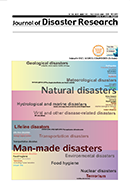17 巻, 1 号
選択された号の論文の19件中1~19を表示しています
- |<
- <
- 1
- >
- >|
Special Issue on COVID-19 and Historical Pandemics Part 2
-
原稿種別: Editorial
2022 年17 巻1 号 p. 5-6
発行日: 2022/01/30
公開日: 2022/01/30
PDF形式でダウンロード (47K) -
原稿種別: Review
2022 年17 巻1 号 p. 7-20
発行日: 2022/01/30
公開日: 2022/01/30
PDF形式でダウンロード (237K) -
原稿種別: Note
2022 年17 巻1 号 p. 21-30
発行日: 2022/01/30
公開日: 2022/01/30
PDF形式でダウンロード (315K) -
原稿種別: Paper
2022 年17 巻1 号 p. 31-42
発行日: 2022/01/30
公開日: 2022/01/30
PDF形式でダウンロード (611K) -
原稿種別: Note
2022 年17 巻1 号 p. 43-50
発行日: 2022/01/30
公開日: 2022/01/30
PDF形式でダウンロード (304K) -
原稿種別: Paper
2022 年17 巻1 号 p. 51-56
発行日: 2022/01/30
公開日: 2022/01/30
PDF形式でダウンロード (186K) -
原稿種別: Paper
2022 年17 巻1 号 p. 57-60
発行日: 2022/01/30
公開日: 2022/01/30
PDF形式でダウンロード (159K) -
原稿種別: Note
2022 年17 巻1 号 p. 61-64
発行日: 2022/01/30
公開日: 2022/01/30
PDF形式でダウンロード (110K) -
原稿種別: Review
2022 年17 巻1 号 p. 65-72
発行日: 2022/01/30
公開日: 2022/01/30
PDF形式でダウンロード (392K) -
原稿種別: Review
2022 年17 巻1 号 p. 73-81
発行日: 2022/01/30
公開日: 2022/01/30
PDF形式でダウンロード (810K) -
原稿種別: Review
2022 年17 巻1 号 p. 82-86
発行日: 2022/01/30
公開日: 2022/01/30
PDF形式でダウンロード (207K) -
原稿種別: Paper
2022 年17 巻1 号 p. 87-92
発行日: 2022/01/30
公開日: 2022/01/30
PDF形式でダウンロード (374K) -
原稿種別: Paper
2022 年17 巻1 号 p. 93-102
発行日: 2022/01/30
公開日: 2022/01/30
PDF形式でダウンロード (308K) -
原稿種別: Note
2022 年17 巻1 号 p. 103-112
発行日: 2022/01/30
公開日: 2022/01/30
PDF形式でダウンロード (267K) -
原稿種別: Paper
2022 年17 巻1 号 p. 113-122
発行日: 2022/01/30
公開日: 2022/01/30
PDF形式でダウンロード (232K) -
原稿種別: Paper
2022 年17 巻1 号 p. 123-135
発行日: 2022/01/30
公開日: 2022/01/30
PDF形式でダウンロード (591K) -
原稿種別: Note
2022 年17 巻1 号 p. 136-143
発行日: 2022/01/30
公開日: 2022/01/30
PDF形式でダウンロード (167K) -
原稿種別: Note
2022 年17 巻1 号 p. 144-151
発行日: 2022/01/30
公開日: 2022/01/30
PDF形式でダウンロード (376K) -
原稿種別: Review
2022 年17 巻1 号 p. 152-158
発行日: 2022/01/30
公開日: 2022/01/30
PDF形式でダウンロード (171K)
- |<
- <
- 1
- >
- >|
